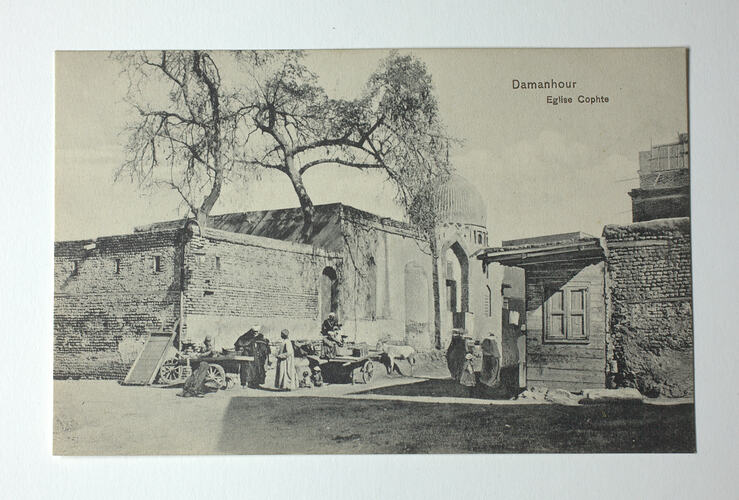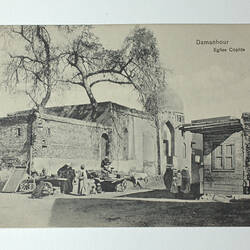Summary
Alternate Name(s): Coptic Church
Postcard from a World War I album from Egypt containing 33 postcards, most featuring Egyptian themes. Of particular interest amongst these postcards is one containing a letter written to 'Father' (presumably John Peile Snr) signed by 'VS' that mentions Albert Peile. The inclusion of this postcard suggests that the album either belonged to or was compiled by John Peile Snr or another member of the Peile family.
Black and white image of a street corner in Damanhour, showing the 'Eglise Copte' (Coptic Church).
Damanhour (or Damanhur; ancient: 'Di Men Hor') was the ancient capital of the seventh Nome of Lower Egypt located in the Western Delta on the Rosetta branch of the Nile. Although the city was dedicated to Horus it was later renamed by the Greek as 'Hemopolis Parva (or Mikra)' which associated the city with both the Greek god Hermes and the Egyptian god Thoth. Today the city is an important railway junction in the Buhayra governorate.
The phrase 'Eglise Cophte' translates from the French to mean 'Coptic Church.' Although there are now two Orthodox Coptic churches and one Evangelical Coptic church in Damanhour, it seems likely that the church depicted is the Orthodox Coptic Church of the Archangel as this was predates the other churches.
Part of a collection of material relating to the World War I service of brothers John and Albert Victor Peile, who both died in the conflict. Younger brother Albert enlisted first. He was a 22-year-old unmarried clerk when he enlisted on 27 August 1914, service number 769, 3rd Battalion. He served in Gallipoli and later France, and was eventually promoted to the rank of corporal. He died in Bullecourt, France on 4 May 1917 and his body was never found. He is commemorated at the Villers-Bretonneux Memorial. His brother John Peile was a 38-year-old unmarried miner when he enlisted on 25 June 1915, service number 2662, 2nd Battalion. He also served in in Gallipoli and France, and was similarly promoted to corporal. He died in France on 18 September 1918 and is buried at Roisel Communal Cemetery Extension, France. Their mother died only a few years later in 1926, aged 73.
Their niece was Mrs M. J. Hitchens, the donor. Margaret Joan Hitchens (1916-?) was the daughter of Albert and John's sister Alice and her husband John Henry Dinwoodie.
Description of Content
Black and white image of a street corner in Damanhour, showing the 'Eglise Copte' (Coptic Church).
Physical Description
Black and white image of a street corner taken slightly off to the right. On the left hand side of the street is a medium sized building with a domed entranceway and a high wall, behind the wall there is a tree. On the other side of the street in a smaller building. There is a group of three figures walking down the street with their backs to the front and a further three figures that appear to be attending to a pair of carts stopped next to the wall.
More Information
-
Collection Names
Military Memorabilia Collection, Returned and Services League (RSL) Collection
-
Collecting Areas
-
Acquisition Information
Donation from Victorian Branch, Returned & Services League of Australia Limited (RSL), Mrs Margaret J. Hitchens, 1986
-
Place & Date Depicted
-
Format
Album
-
Inscriptions
Printed on the front of the postcard, top right: 'Damanhour / Eglise Cophte'
-
Classification
-
Category
-
Discipline
-
Type of item
-
overall dimensions
138 mm (Width), 89 mm (Height)
-
References
'Damanhur,' Tour Egypt, at: [Link 1] accessed: August 2, 2012 'Damanhour,' Wikipedia, at: [Link 2] accessed: August 2, 2012 Otto Frederich August Meinardus, Two Thousand Years of Coptic Christianity, American University of Cairo Press (Egypt, 1999); p.171, at: [Link 3] accessed: August 6, 2012 For John Peile's war record see the National Archive of Australia website at: [Link 4] For Albert Peile's war record see the National Archives of Australia website at: [Link 5]
-
Keywords
World War I, 1914-1918, Streetscapes, Postcards, Churches, Religions: Christianity


